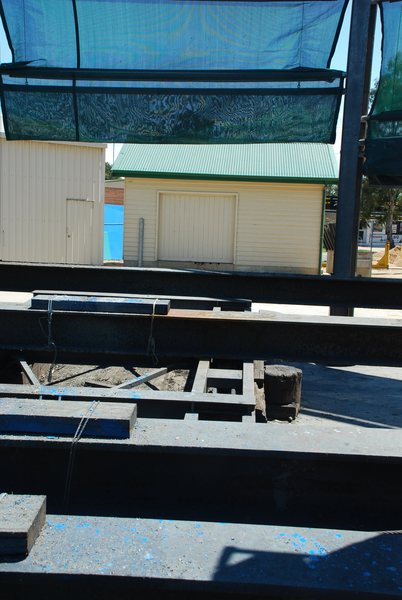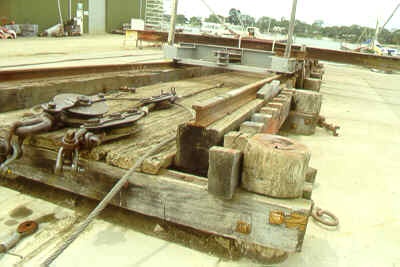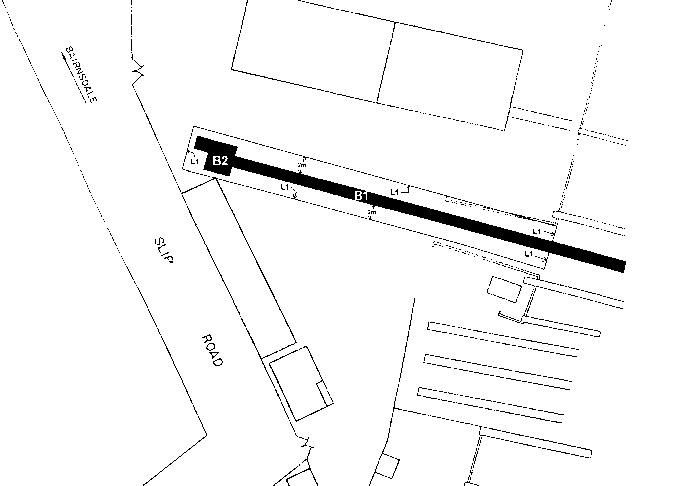SLIP AND WINCH SHED
PAYNESVILLE SLIPWAY, 60-74 SLIP ROAD PAYNESVILLE, EAST GIPPSLAND SHIRE
-
Add to tour
You must log in to do that.
-
Share
-
Shortlist place
You must log in to do that.
- Download report






Statement of Significance
The Slip at Paynesville was constructed in 1887 by a Dane called Erickson and was later purchased, at some time prior to 1914, by a Scot named Peter Tierney who used the facility for ship building. The Slipway was sold to the Victorian Government in 1914 and is believed to have been in continuous use since that time. The Slipway is associated with the construction of the SS JCD, constructed by Erickson in 1888, which operated on the Lakes until 1934. The SS Gippsland was also constructed at the slipway in 1908, this was the largest vessel to operate in the lakes and later saw active service in 1942 as the HMAS Gippsland. The Slipway was also the site of a hand operated punt, constructed in 1903, which ran across the McMillan Straits between the mainland and Raymond Island, the punt was later removed and used by Bull’s Shipyard at Metung. The slipway site has been much altered since its establishment, however a timber slip and winch shed remain to represent the site, as it would have been. The Slip is a timber structure, which has substantial timber members in its construction. A steel cradle sits on this and is attached to the winch, which is housed in a simple weatherboard building.
How is it significant?
The Slip and Winch shed at Paynesville is of historical, technical and aesthetic importance to the State of Victoria.
Why is it significant?
The Slip and Winch shed at Paynesville are of historical importance for their ability to demonstrate the importance of shipping in the Lakes region of East Gippsland. They are important for their representation of the lucrative intra-lakes and ocean shipping trade, which operated between 1858 and 1931. This trade disappeared only when it could not compete with a well-established and regular rail and road transport service. The slip is important for its demonstration of the history of ship building in Victoria. It is important for its associations with well-known ship builders and ships. Of all the early builders in Gippsland, probably the biggest and best known, were Sylvia Erickson and Peter Tierney, at Paynesville. When Erickson retired, Tierney took over the business. The former built the very successful SS JCD for Dahlsen, and the latter the equally successful SS Gippsland.
-
-
SLIP AND WINCH SHED - History
Contextual History:
The town of Paynesville is centrally located on the East Gippsland Lakes on a sheltered strait formed by the mainland and Raymond island which links Lakes King and Victoria. These two lakes, along with Lake Wellington, comprise the major part of the chain of lagoons, formed by submerged coastal plains enclosed by sandy barriers, which comprise the East Gippsland Lakes .
The region was first settled by Europeans following exploration between 1839-41 and the first land sales in 1843. Shipping was important to the area prior to the establishment of railways in 1877-79. Road, rail and water-borne transport appears to have later established itself as an interconnecting and integrated network throughout the lakes region .
By 1878 Toonallook, renamed Paynesville in 1879 after the fisheries inspector and Harbour Master Captain Payne, is believed to have an established fishing and fish curing industry which supplied fresh and preserved fish to local regional centres and to Melbourne in the cooler seasons .
Between 1858 and 1931 a lucrative intra-lakes and ocean shipping trade developed, a trade that disappeared only when it could not compete with a system, a swift, regular rail and road transport service .
With the development of the shipping trade there came the need to establish facilities to repair, convert and build various types of craft. Before the close of the era such work was being carried out at various places, from Tabarra on the Brodribb to the canal at Sale . Of all the early builders, probably the biggest and best known were Sylvia Erickson and Peter Tierney, at Paynesville. When Erickson retired, Tierney took over the business. The former built the very successful J.C.D. for Dahlsen, and the latter the equally successful Gippsland .
The J.C.D., built by Erickson for J.C.Dahlsen of Bairnsdale, traded between 1889 and 1936. Peter Tierney, who took over Erickson’s yards at Paynesville, built the steam-ship Gippsland, the largest and fastest passenger ship in the trade, and the pride of the Dahlsen Line. She was launched in 1908, and after 30 years of eventful service was sold to Hegarty’s, who ran her unsuccessfully as a Sydney ferry for a short time. After that she became a Brisbane show-boat-again a failed venture. During the second World War she served first as a navigation training vessel at Jervis Bay, and then as a mine sweeper in the northern seas. A salvage company bought her after the war, and she ended her days storm-wrecked in New Guinea waters .
History of Place:
The slipway at Paynesville was constructed in 1887 by a Dane called Erickson and was later purchased, at some time prior to 1914, by a Scot named Peter Tierney who used the facility for shipbuilding. The slipway was sold to the Victorian Government in 1914 and is believed to have been in continuous use since that time .
The slipway is associated with the construction of the S.S. J C D, constructed by Erickson in 1888 and operated on the Lakes until 1934. The S.S. Gippsland was constructed at the slipway in 1908, this was the largest vessel to operate in the lakes, it later saw active service in 1942 as the HMAS Gippsland. The slipway was also the site of a hand operated punt, constructed in 1903, which ran across the McMillan Straits between the mainland and Raymond Island, the punt was later removed and used by Bull’s Shipyard at Metung .
The variety of buildings which occupy the slipway complex suggest that the facility has been continually altered to meet changing requirements of use. Of the four slipways and three winch sheds, the large slip and associated winch shed is the only one in use. The office and store, now used by local water police appears to have been constructed in the late 1950s or early 1960s. The new steel framed brick clad machinery shed has been under construction since 1985 .
The Gippsland
The Gippsland was the fastest, and most beloved of all the lake steamers. It was 120 feet long, capable of twelve knots, was launched at half past two, Friday afternoon, 3 July 1908 from the Paynesville slipyard. She was built by Peter Tierney and cost twelve hundred pounds, for J. C. Dahlsen & Co. Her first trip, Bairnsdale to Cunninghame (Lakes Entrance) and back was on Boxing Day 1908. She was licensed to carry 600 passengers on rivers, and 477 on lakes. The captain’s and engineers cabins were on the main deck, below were the crew’s quarters a dining room, saloon and bar. She burned between four and six tons of red gum a trip. This appetite kept Charles Leyshan, the McNamara brothers, and other contract woodcutters and woodcarters busy, at seven and sixpence a ton of three foot lengths, maintaining a sixty ton stack of fuel always ready on Bairnsdale wharf. She had a six-foot propeller of phosphor bronze.
Although she had workday tasks-weekly trips to Paynesville and Lakes Entrance to pick up fish or vegetables and onions from Raymond island-she was essentially a tourist ship, a pleasure vessel so popular right from the start that she repaid her cost within three years.
On Guy Fawkes’ day 1937 the Gippsland left the Bairnsdale wharf for ever, downstream to the river mouth, across lake king, through Reeves Channel, the Narrows, and finally, the Entrance itself, out into Bass Strait on her way to Sydney.
Captain N.D. Hegarty had bought her for fifteen hundred pounds with the idea of using her for a Sydney Harbour ferry or tourist cruiser. One Manly trip and several on the Lavender Bay run revealed her as neither deft nor economical. In January 1938, loaded with onlookers at a re-enactment of Captain Arthur Philip’s landing at Sydney Cove, she carried her last full implement of passengers. Captain Hegarty then sent her to Brisbane as a showboat–river trips with vaudeville acts aboard. It was a highly unsuccessful venture.
The Red Funnel Trawlers Company bought her; stripped off top deck; converted her into the mother ship of a fleet trawling off the New Sales Wales coast.
In 1942 she was taken over by the Royal Australian Navy, and as HMAS Gippsland used for a minefield repair ship. As well under Commander L.E. Forsyth, she served as seagoing tender, on duty from first light Monday to sunset Friday, for the training of potential officers in navigation and engineering.
When the war had ended, a treasure seeking Frank Macrae, his three brothers, and a Captain H.W. Gutherie bought the demobilised Gippsland. She set off shabby and dogged, on the last lap of all. Almost exactly thirty six years after Mrs J. C. Dahlsen had christened her with champagne at Paynesville slipyard, the Gippsland was wrecked on a reef off New Guinea and went down. The aft passenger deck was piled high with reserve bunker coal, the bar space crammed with salvage gear, and spare water butts stacked where the piano had stood.
Associated People: Ship builders Sylvius Erickson and Peter TierneySLIP AND WINCH SHED - Assessment Against Criteria
Criterion A
The historical importance, association with or relationship to Victoria's history of the place or object.
The Paynesville slipway, particularly the slips and winch sheds, is of historical importance for its ability to demonstrate the importance of shipping in the Lakes region of East Gippsland. It is important for its representation of the lucrative intra-lakes and ocean shipping trade which operated between 1858 and 1931. This trade disappeared only when it could not compete with a well established and regular rail and road transport service. The slip is important for its demonstration of the history of ship building in Victoria. It is important for its association with the construction of the S.S. JCD and the S.S. Gippsland which was the largest vessel to operate in the Lakes region.
Criterion B
The importance of a place or object in demonstrating rarity or uniqueness.
The large slip at Paynesville is important as a rare intact example of a slip constructed before 1900.
Criterion C
The place or object's potential to educate, illustrate or provide further scientific investigation in relation to Victoria's cultural heritage.
The slip can provide valuable insights into the history of ship building in Victoria.
Criterion D
The importance of a place or object in exhibiting the principal characteristics or the representative nature of a place or object as part of a class or type of places or objects.Criterion E
The importance of the place or object in exhibiting good design or aesthetic characteristics and/or in exhibiting a richness, diversity or unusual integration of features.
The slip and winch shed is a particularly intact example of a timber slip. The slip exhibits fine timber work details in its construction.
Criterion F
The importance of the place or object in demonstrating or being associated with scientific or technical innovations or achievements.
The slip is of technical interest as it demonstrates early slip construction and demonstrates fine detailing.
Criterion G
The importance of the place or object in demonstrating social or cultural associations.
Paynesville Slipway has important associations to the well- known ship builders Sylvius Erickson and Peter Tierney. Tierney, a Scotsman built many other vessels in the slip prior to 1914 before he sold it to the Victorian Government for a dredging depot.
Criterion H
Any other matter which the Council considers relevant to the determination of cultural heritage significanceSLIP AND WINCH SHED - Permit Exemptions
General Exemptions:General exemptions apply to all places and objects included in the Victorian Heritage Register (VHR). General exemptions have been designed to allow everyday activities, maintenance and changes to your property, which don’t harm its cultural heritage significance, to proceed without the need to obtain approvals under the Heritage Act 2017.Places of worship: In some circumstances, you can alter a place of worship to accommodate religious practices without a permit, but you must notify the Executive Director of Heritage Victoria before you start the works or activities at least 20 business days before the works or activities are to commence.Subdivision/consolidation: Permit exemptions exist for some subdivisions and consolidations. If the subdivision or consolidation is in accordance with a planning permit granted under Part 4 of the Planning and Environment Act 1987 and the application for the planning permit was referred to the Executive Director of Heritage Victoria as a determining referral authority, a permit is not required.Specific exemptions may also apply to your registered place or object. If applicable, these are listed below. Specific exemptions are tailored to the conservation and management needs of an individual registered place or object and set out works and activities that are exempt from the requirements of a permit. Specific exemptions prevail if they conflict with general exemptions. Find out more about heritage permit exemptions here.Specific Exemptions:General Conditions:
1. All exempted alterations are to be planned and carried out in a manner which prevents damage to the fabric of the registered place or object.
2. Should it become apparent during further inspection or the carrying out of alterations that original or previously hidden or inaccessible details of the place or object are revealed which relate to the significance of the place or object, then the exemption covering such alteration shall cease and the Executive Director shall be notified as soon as possible.
3. If there is a conservation policy and plan approved by the Executive Director, all works shall be in accordance with it.
4. Nothing in this declaration prevents the Executive Director from amending or rescinding all or any of the permit exemptions.
Nothing in this declaration exempts owners or their agents from the responsibility to seek relevant planning or building permits from the responsible authority where applicable.
* No permit is required for maintenance of cradle and winch to ensure their continuing operation.
* No permit is required for replacement of winch machinery, provided that the machinery being replaced is retained on site under cover.
-
-
-
-
-
Fisherman's Cottage
 National Trust
National Trust -
Paynesville War Memorial
 Vic. War Heritage Inventory
Vic. War Heritage Inventory -
Paynseville Hall Honour Roll (First World War)
 Vic. War Heritage Inventory
Vic. War Heritage Inventory
-
'Lawn House' (Former)
 Hobsons Bay City
Hobsons Bay City -
1 Fairchild Street
 Yarra City
Yarra City -
10 Richardson Street
 Yarra City
Yarra City
-
-












